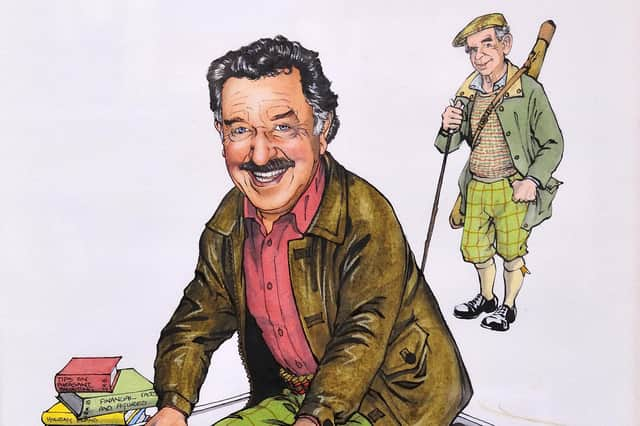Obituary: James Hardie Brown, Scottish civil engineer and sportsman


James Hardie Brown, who, with his brother Ian, founded the construction and civil engineering firm I & H Brown, one of the largest such businesses in Scotland, died at St Margaret’s Community Hospital in Auchterarder. He was 90.
Brown – known all his life as “Hardie” – was born in Dunfermline in 1930, to Jennie and Davie Brown, a farmer. Hardie grew up at Carnock Mill Farm with his older brother Ian, who died in 2015, and sister Betty. He attended Dunfermline High School until leaving to help his brother on the farm.
Advertisement
Hide AdAdvertisement
Hide AdIn the 1950s the brothers moved to Perthshire, where they bought Innergask Farm in the parish of Findo Gask. Part of the land was covered by a concrete aerodrome and in the late Fifties Ian and Hardie decided to get rid of it. To break it up they used a Traxcavator, which aroused interest in the neighbourhood, and they began renting out the machine. This inspired their plant hire business, and in 1964 they founded I & H Brown, which would diversify into construction, mining, house-building and land remediation. Eventually the business extended to the acquisition and operating of Highland estates. I & H Brown now own some 4,000 acres in Fife, Perthshire and East Lothian, producing barley, wheat, potatoes, oilseed rape and grasses. For some years Hardie was chairman of the Perth Show.
While civil engineering remains a core activity of I & H Brown, the company’s expertise in mining, and the skills involved with land remediation and reclamation, led to a prescient interest in the environment and a vision of what could be done with renewables. The company developed wind farms at Calliachar and Toddleburn, along with new ways of engineering previously uncontrolled landfill sites. Describing the company’s approach, Hardie said: “We always looked for a second use.”
The Brown brothers were fascinated by machinery. As Hardie put it: “Our business has been like a boyhood dream because we loved plant.” Hardie served as Chairman of the Scottish Plant Owners Association. When he indulged his love of travel, wherever he went he managed to slip in a view of the latest earthmoving equipment.
Hardie delighted in acquiring lorries and painting them in ever-brighter colours. One day Ian had to tell him firmly that he was buying too many. The mischievous Hardie recalled: “I said to him, all right, you have my word that as from this moment in time I won’t buy any more. He didn’t know that that morning I’d bought ten.”
Hardie’s biggest interest in life remained I & H Brown. Even after semi-retirement he would come into the office with his son in the mornings to open the mail – he had an uncanny ability to spot envelopes which contained cheques. “And I’m the only person who switches off lights,” he said.
He was also a keen sportsman, with car rallying, shooting and curling his chief passions. He was an active, extremely competitive, member of the 55 Car Club and co-driver, with brother-in-law Bobby Crawford, in the famed Monte Carlo rally, driving a Mini Cooper. Sprints and other race activities took place on the Brown property at Gask. He travelled abroad to attend Formula One events in Europe and South America, often with another brother-in-law, Tom Muir, who found him very outgoing: “He could speak to anyone. I would love to have known both Hardie and Ian as young men – they must have been tremendous fun and so full of beans.”
Hardie loved shooting all his life – in early years, a day out with neighbouring farmers, and latterly, at the family farm near Auchterarder. “His shoots were always jovial, with a bunch of interesting people,” recalled Iain Bett, a colleague in the plant industry. “Hardie never looked for big bags. It was the conviviality that mattered.”
A member of Findo Gask and Broomhall Curling Clubs, Hardie had the honour of being “made”. This curious rite took place at Broomhall where, as a protégé of his friend Lord Elgin, he came to no real harm. The two probably enjoyed an outdoor bonspiel or two in winters when the ice was hard enough.
Advertisement
Hide AdAdvertisement
Hide AdFormer Prime Minister Gordon Brown, a relative, was in awe of Hardie’s business acumen. Speaking at Hardie’s funeral at Perth on 29 March – by proxy, due to Covid restrictions – he extolled “the scale of his achievement – not one achievement but a record of continuous achievement in farming and in every sphere of business he entered… all singular successes, one after another.” Gordon quipped: “I have always thought that if any family member was to be Chancellor of the Exchequer it should have been Hardie! I’m not sure he would have put up the tax on cigars, which he liked greatly, or wine.’
Hardie Brown married Betty Miller in 1955 and they had two children, Scott and Shane Elizabeth. Hardie and Betty divorced in 1988; he then married Carol Ann Muir, with whom he lived at Mid Fordoun Farm, Auchterarder.
In his later years, Hardie suffered from dementia. He is survived by Carol, his son Scott, who now directs the family firm, and daughter Shane. His sister Betty Little lives in Yorkshire. In addition he is survived by two stepchildren, Ann-Maree and Russell, four grandchildren, Abigail, Duncan, Edward and Michael, and a great-granddaughter, Hallie.